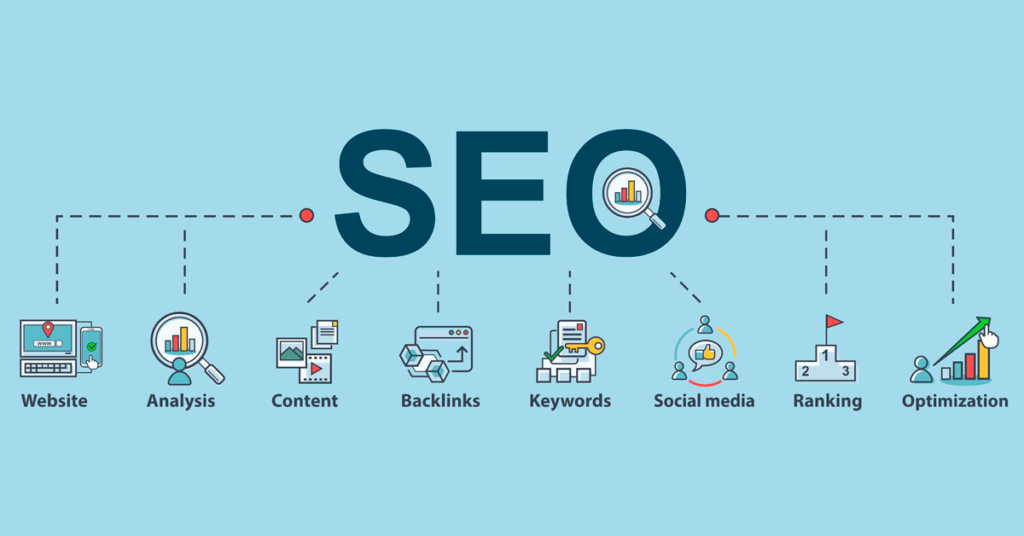Introduction
Understanding Search Engine Optimization (SEO) is crucial for companies, bloggers, and website owners that want to increase their online visibility in the modern digital environment. SEO is the foundation of online success, regardless of your goals—whether they are to boost sales, establish brand authority, or improve website traffic.
From fundamental techniques to more complex strategies, this guide will lead you through tried-and-true SEO strategies so you can increase website visibility and see rapid growth. Let’s examine the essential elements that will enable you to become an SEO expert.

1. Understanding the Basics of SEO
Understanding the fundamentals of SEO is crucial before implementing more complex tactics. In order for search engines like Google to crawl, index, and rank your website higher for pertinent search queries, you must optimize it.
Key SEO Components:
- On-Page SEO: This focuses on optimizing features within your website. Keywords, meta descriptions, title tags, URL structure, and content quality are important components.
- The activities you do outside of your website to raise its rankings are known as off-page SEO. Link building is the most crucial off-page component, where your content is linked to by high-quality backlinks from reliable websites.
- Technical SEO is the process of improving the backend of your website. It consists of organized data, mobile friendliness, secure connections (HTTPS), and site performance.
You’ll have a strong base upon which to develop if you comprehend these fundamentals.
2. Conducting Thorough Keyword Research
The foundation of a great SEO strategy is thorough keyword research. You can produce material that appeals to your audience by knowing what they are looking for.
Steps for Effective Keyword Research:
- List Relevant Topics: Consider the primary topics that your company or website addresses.
- Use Keyword Tools: You may find keyword ideas with low competition and high search traffic by using tools like Ubersuggest, SEMrush, Ahrefs, and Google Keyword Planner.
- Long-Tail Keywords: Pay attention to long-tail keywords, which are three-word or longer phrases. These have greater conversion rates since they are less competitive and frequently more targeted.
- Determine the Search Intent: Recognize the intent underlying search terms. Are people seeking items (transactional intent), services (navigational intent), or information (informational intent)?
You may make sure that your content satisfies the expectations of your audience by using the appropriate keywords.
Also Read: https://playsmtv.xyz/google-chrome-unleash-full-potential-of-world-browser/
3. Crafting High-Quality, Optimized Content
When it comes to SEO, content is king. Both search engines and consumers are drawn to high-quality content, which lengthens their stay on your website and increases the chance they will convert.
Best Practices for Content Creation:
- Always put the user experience first when writing for your audience. Make material that interests readers, offers value, and responds to queries.
- Use your desired keywords naturally in your content to optimize it for search engines. Incorporate them into the article’s opening 100 words as well as headings and subheadings. Don’t stuff keywords, though.
- Make Use of Multimedia Adding pictures, videos, and infographics to your content can increase its shareability and engagement.
- Length of Content: Although longer content often performs better, quality matters more than length. A 1,500+ word, thoroughly researched article frequently scores higher than shorter content.
Keep in mind that high-quality content improves your off-page SEO by attracting backlinks from other websites in addition to satisfying search engines.

4. Optimizing On-Page SEO Elements
Your website’s rankings are most directly affected by on-page SEO. To be as effective as possible, a few essential components must be maximized.
Key On-Page SEO Factors:
- Title Tags: One of the most crucial SEO components is the title tag. It should include your goal term and be compelling. To guarantee that it appears completely in search results, keep it to 60 characters or less.
- Meta Descriptions: Although they have no direct impact on rankings, meta descriptions do have an impact on click-through rates (CTR). Include your keyword in succinct, compelling descriptions that have a clear call to action.
- Headings: Make use of headings (H1, H2, H3) to organize your material. Use other pertinent keywords in H2 and H3, and make sure your primary keyword appears in your H1 tag, which is typically the page title.
- Structure of URLs: Clear, informative URLs are easier for users to navigate and aid search engines in comprehending the content of your page. As an illustration, “www.example.com/seo-strategies” is superior to “www.example.com/page123.”
- Internal Linking: To aid search engines in comprehending the hierarchy of your website and allocating link equity, include links to other pertinent sites.
- Alt Text for Images: Make sure your images have meaningful alt text at all times. This enhances accessibility and aids in image search engine optimization.
5. Building High-Quality Backlinks
Backlinks, or links pointing to your content from other websites, are the main force behind off-page SEO. Getting high-quality backlinks is crucial for raising your results since Google sees them as endorsements.
Strategies for Building Backlinks:
- Guest Blogging: Provide insightful articles with backlinks to your website for other respectable websites in your field.
- Finding broken links on related websites and providing your material as a substitute is known as “broken link building.”
- Skyscraper Method: Locate well-liked content in your niche, improve it, and then contact the websites that link to the original to inform them of your improved version.
- Join Communities: Take part in blogs, social media groups, and forums where you may exchange content and establish connections with people in your field.
Google views your website as more authority the more high-quality backlinks it receives, which raises its rating.
Also Read: https://playsmtv.xyz/build-strong-foundation-how-business-insurance-safe/
6. Technical SEO: Enhancing User Experience
Effective crawling and indexing of your website by search engines is guaranteed by technical SEO. Enhancing user experience (UX), which has a big impact on SEO performance, is also essential.
Essential Technical SEO Tips:
- Site Speed: Websites with slower speeds have greater bounce rates. To assess and enhance the speed of your website, use resources such as Google PageSpeed Insights.
- Mobile-Friendliness: A responsive website design is essential due to mobile-first indexing. Make sure your website looks fantastic on all devices because Google favors mobile-friendly websites.
- Secure Website (HTTPS): Users and search engines alike trust websites that have SSL certificates. In case you haven’t already, switch to HTTPS.
- XML Sitemaps: To improve search engine crawling efficiency, make sure your website contains an XML sitemap.
- Correct Crawl faults: Make sure that all significant pages are indexed by using Google Search Console to find and correct crawl faults.

7. Staying Ahead of the Competition with Advanced SEO Tactics
You can use more sophisticated tactics to raise your ranks after you’ve mastered the fundamentals.
Advanced SEO Techniques:
- Schema Markup: Use Schema.org to include structured data into your website. This improves CTR by assisting search engines in comprehending the content of your sites and may result in rich snippets appearing in search results.
- Optimize your content for conversational keywords and long-tail terms that consumers use while speaking instead of typing as voice search gains popularity.
- material Clusters: Use a pillar page that connects to relevant subpages to group your material into clusters. This aids search engines in determining the topical authority of your website.
- Local SEO: Claim your Google My Business listing, promote reviews, and make sure your NAP (Name, Address, Phone number) is consistent across directories to optimize your website for local search.
8. Monitoring and Analyzing Your SEO Performance
Since SEO is a long-term endeavor, you must monitor your progress if you want to see steady results. Track important performance indicators with tools like Ahrefs, SEMrush, or Google Analytics.
Key Metrics to Track:
- Bounce Rate: The percentage of visitors who leave after viewing only one page.
- Keyword Rankings: The positions of your targeted keywords in search results.
- Organic Traffic: The number of visitors arriving from search engines.
- Conversion Rate: The percentage of visitors who take a desired action, such as purchasing a product or signing up for a newsletter.
By consistently analyzing your performance, you can make data-driven decisions and refine your strategy.
9. Leveraging Social Media for SEO Synergy
While social media doesn’t directly impact SEO rankings, it can play a crucial role in driving traffic, increasing visibility, and amplifying your content. Social signals, like shares and engagement, can indirectly influence your search engine performance by generating more backlinks, brand mentions, and traffic.
How Social Media Supports SEO:
- Increased Traffic: Sharing content on social media platforms can bring more visitors to your website. The higher the engagement and traffic, the more likely search engines will consider your content valuable and relevant.
- Building Brand Awareness: Social media helps you reach a wider audience, build a community, and establish trust, which may lead to more organic backlinks as people discover and reference your content.
- Engagement and User Signals: Platforms like Twitter, Facebook, LinkedIn, and Instagram can give search engines a sense of the quality and relevance of your content based on likes, shares, and comments. Engaging with your audience directly can help increase your content’s authority.
- Improved Brand Search Volume: As your brand becomes more recognized, people may begin searching for it directly on search engines. This increased search volume can help your rankings improve over time.
By incorporating social media into your overall SEO strategy, you can enhance the reach and impact of your content, driving more organic traffic and improving your website’s authority.

Conclusion
Mastering SEO takes time, but by implementing the strategies outlined in this guide, you’ll be on the path to driving massive traffic, increasing your website’s authority, and achieving long-term growth. Remember to stay up-to-date with the latest SEO trends, consistently optimize your content, and focus on providing value to your audience. With patience, dedication, and the right approach, you’ll soon be reaping the rewards of your SEO efforts.